Abstract
Serum taken after the termination of microfilaraemia from rats infected with the filarial parasite Litomosoides carinii brought about adherence and cytotoxicity of normal rat spleen and peritoneal cells to microfilariae. The activity could be absorbed to, and eluted from, anti-rat IgE, but not anti-rat IgG, immunosorbent columns. Immune serum heated to 56 degrees C for 3 hr did not cause cellular adherence or cytotoxicity; the addition of fresh normal rat serum failed to restore activity. Fresh rat serum did, however, restore activity to immune serum which was inactive after being heated to 56 degrees C for 30 min. EDTA, EGTA and diethylcarbamazine inhibited adherence. It is concluded that IgE antibodies are responsible for cellular adherence and cytotoxicity and that complement may play a part, as yet undefined, in these reactions.
Full text
PDF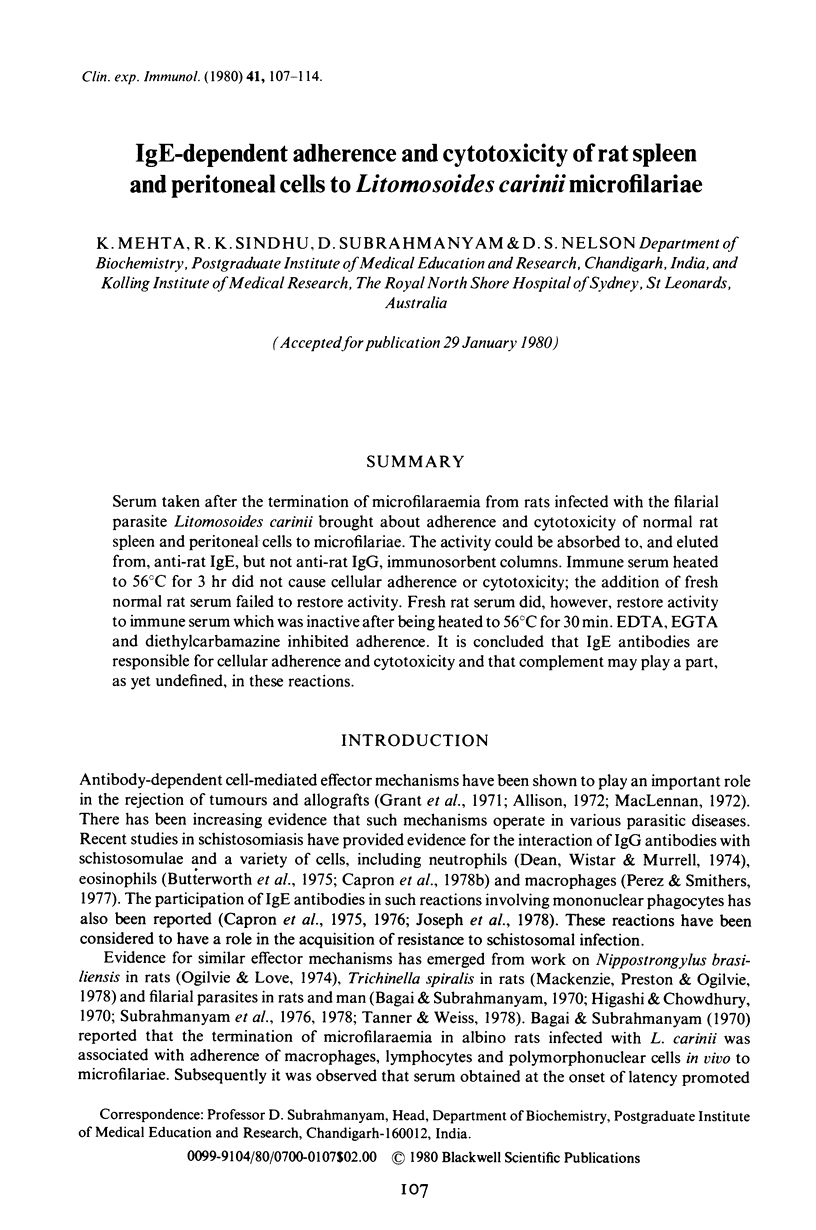

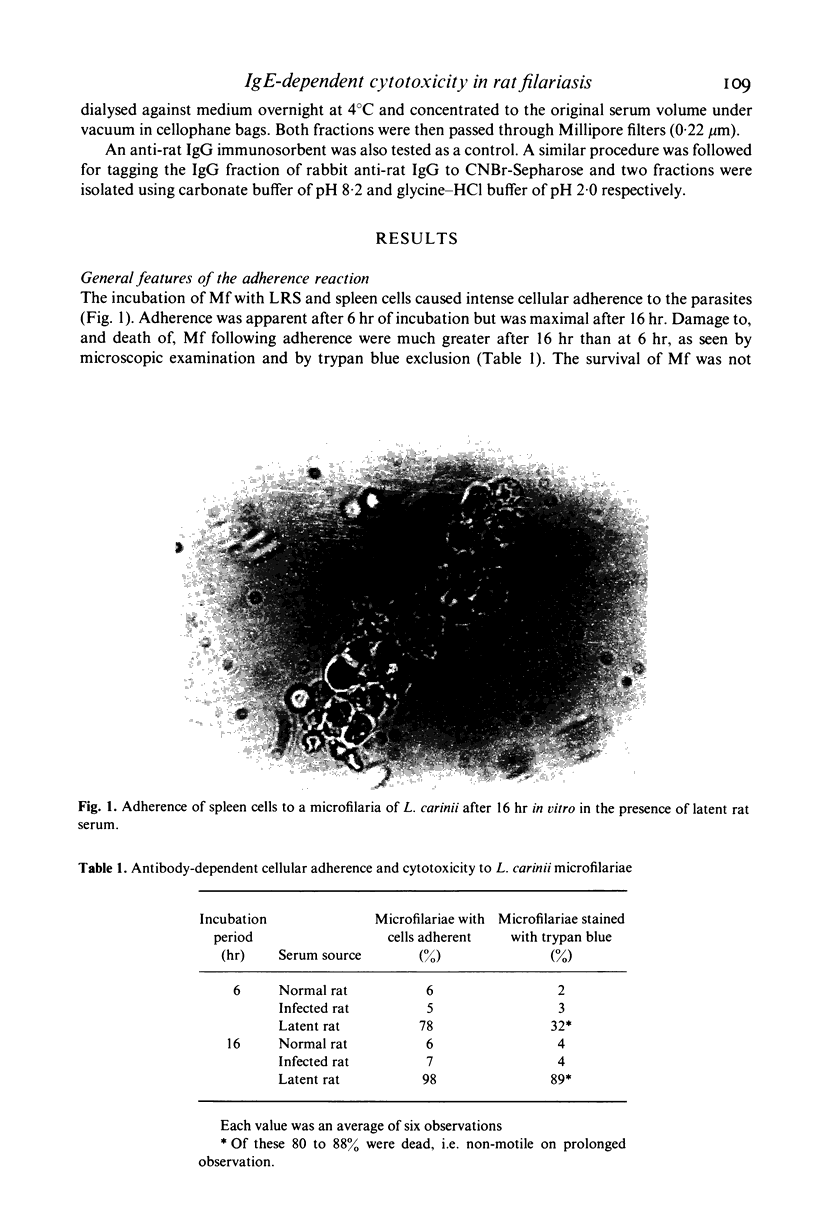
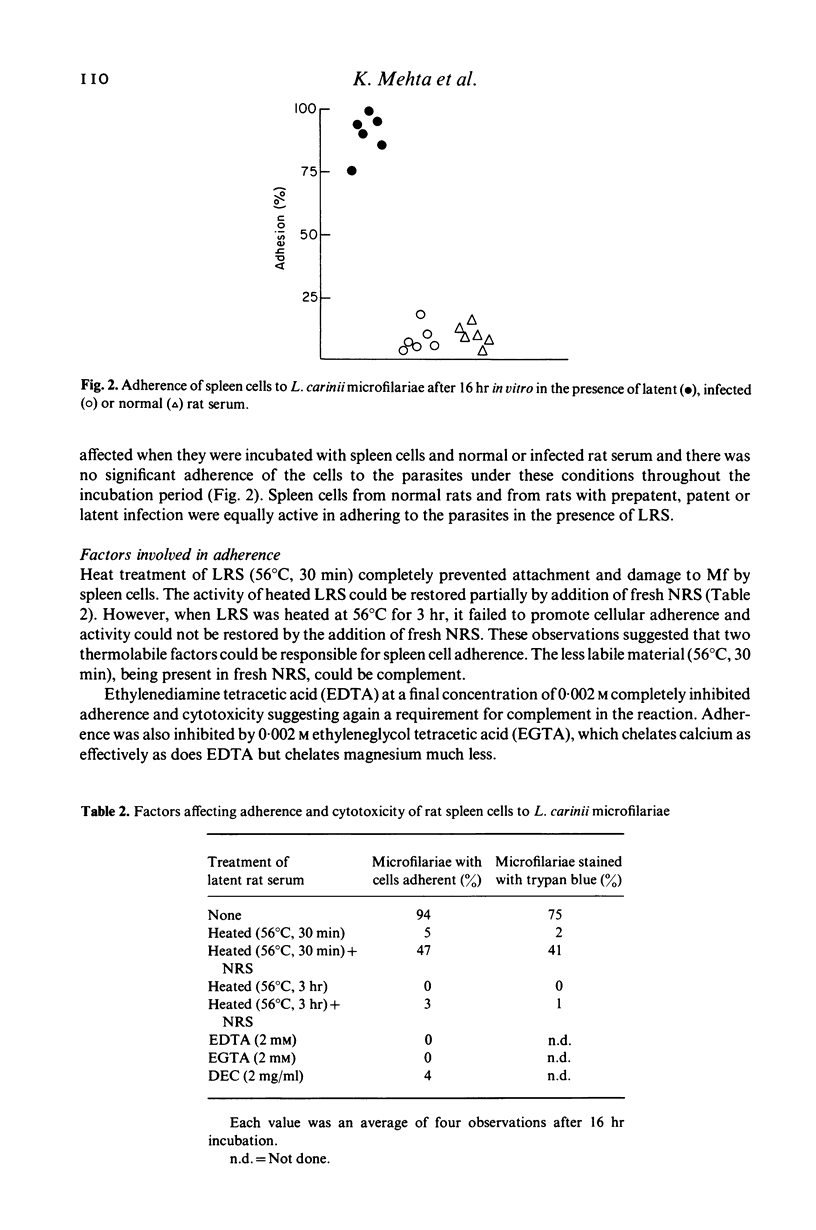
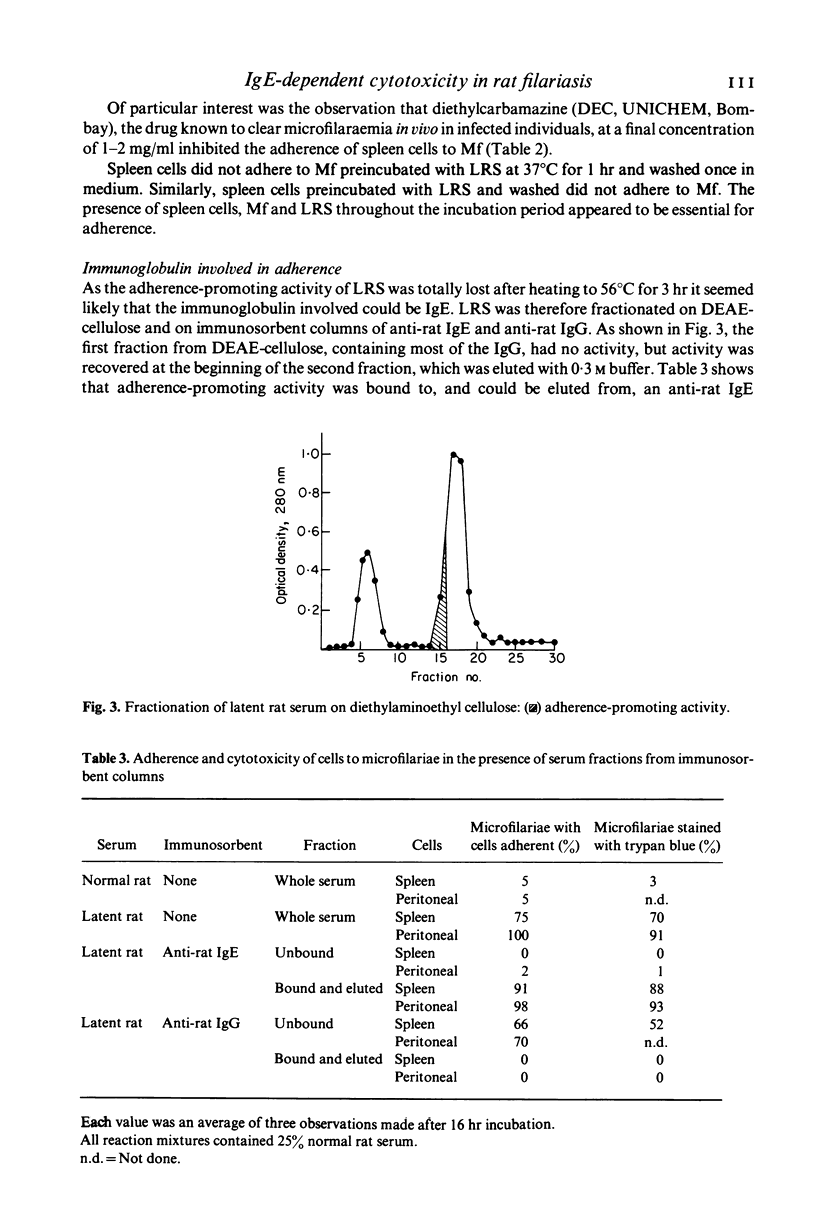
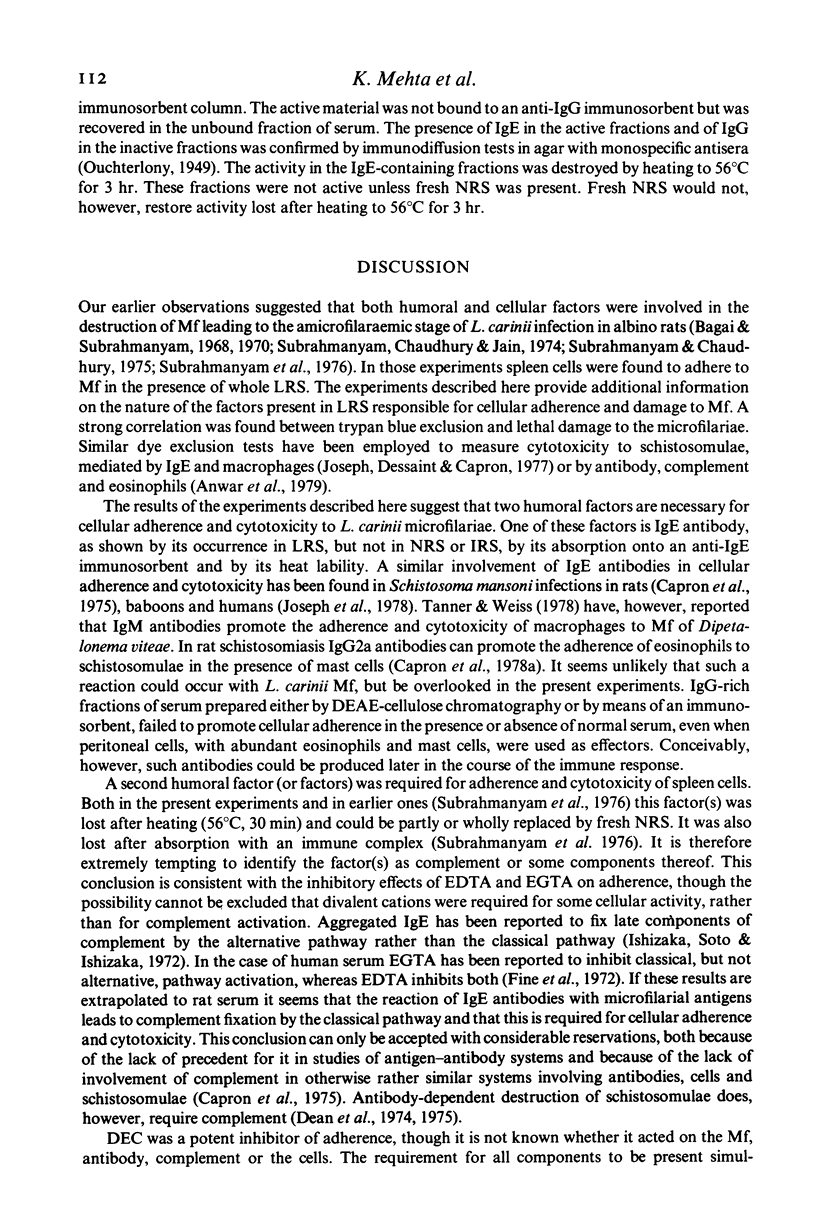
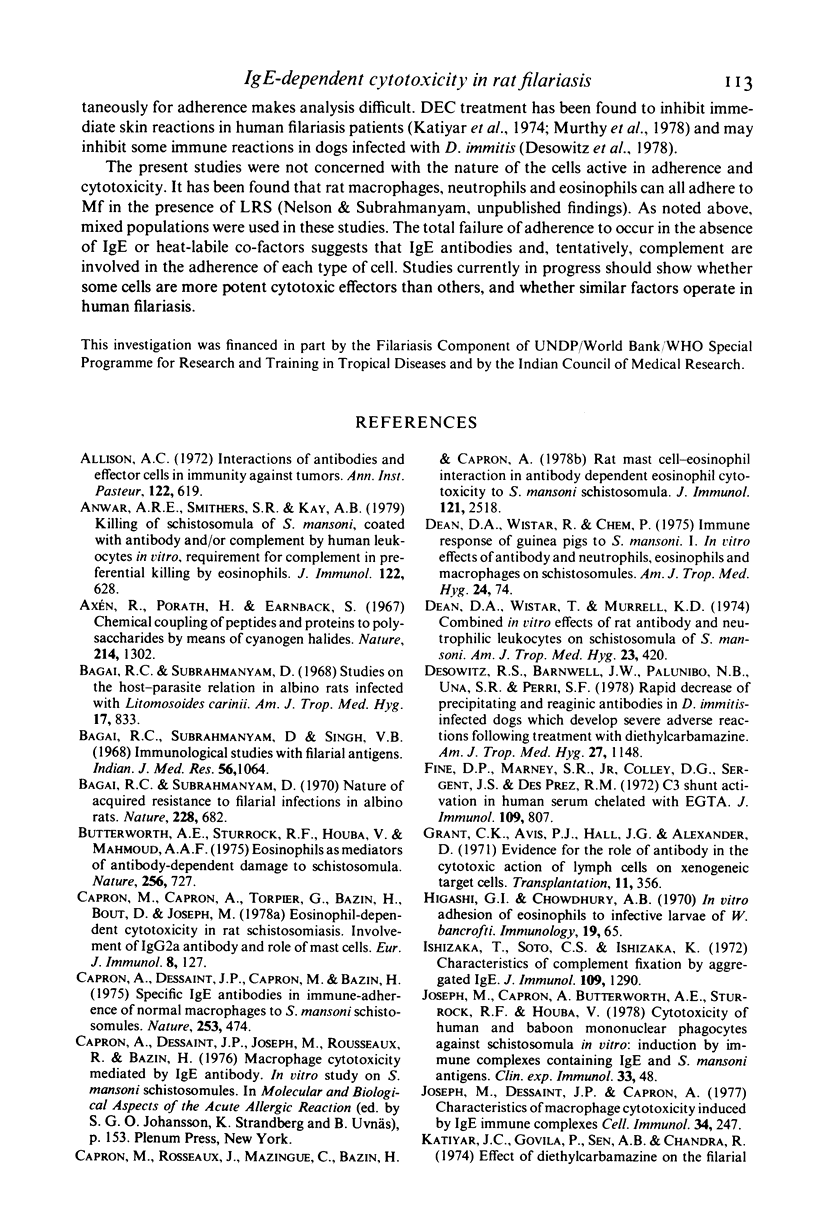
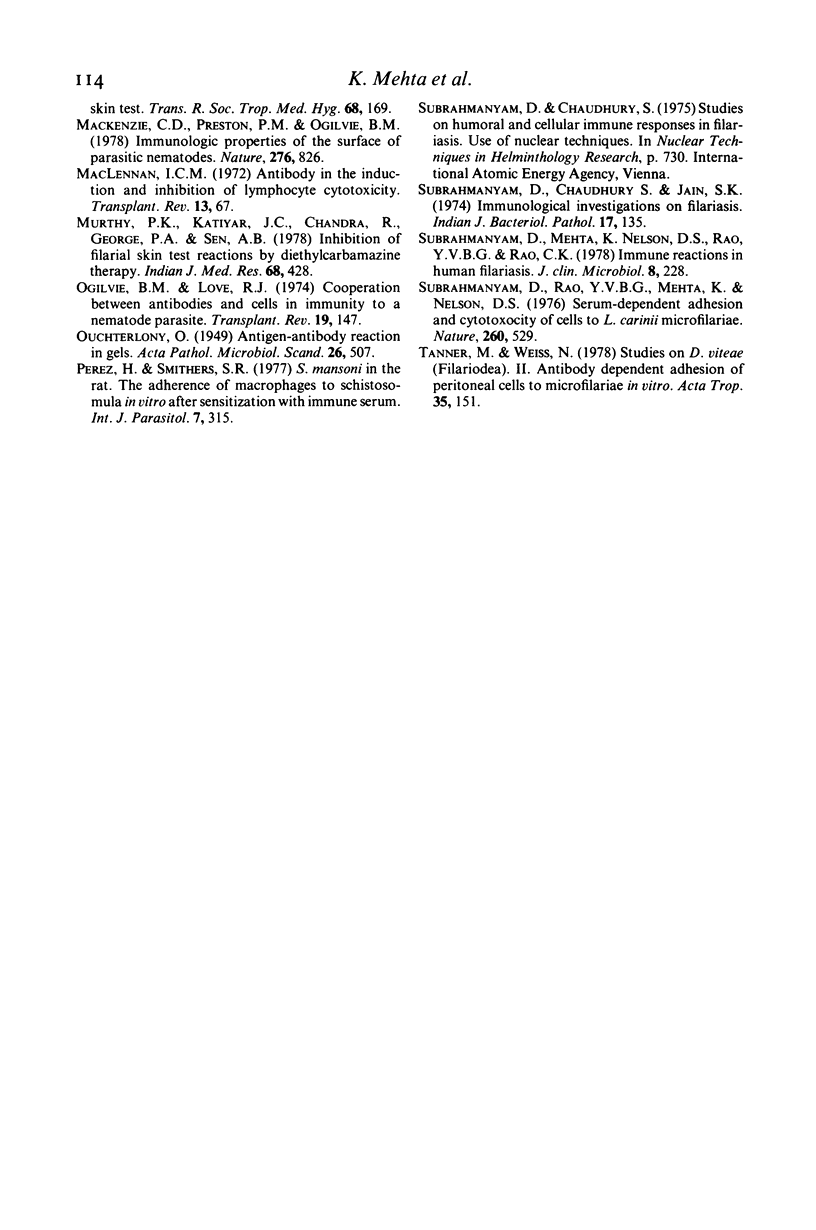
Images in this article
Selected References
These references are in PubMed. This may not be the complete list of references from this article.
- Allison A. C. Interactions of antibodies and effector cells in immunity against tumours. Ann Inst Pasteur (Paris) 1972 Apr;122(4):619–631. [PubMed] [Google Scholar]
- Anwar A. R., Smithers S. R., Kay A. B. Killing of schistosomula of Schistosoma mansoni coated with antibody and/or complement by human leukocytes in vitro: requirement for complement in preferential killing by eosinophils. J Immunol. 1979 Feb;122(2):628–637. [PubMed] [Google Scholar]
- Axén R., Porath J., Ernback S. Chemical coupling of peptides and proteins to polysaccharides by means of cyanogen halides. Nature. 1967 Jun 24;214(5095):1302–1304. doi: 10.1038/2141302a0. [DOI] [PubMed] [Google Scholar]
- Bagai R. C., Subrahmanyam D. Nature of acquired resistance to filarial infection in albino rats. Nature. 1970 Nov 14;228(5272):682–683. doi: 10.1038/228682a0. [DOI] [PubMed] [Google Scholar]
- Bagai R. C., Subrahmanyam D., Singh V. B. Immunochemical studies with filarial antigens. Indian J Med Res. 1968 Jul;56(7):1064–1073. [PubMed] [Google Scholar]
- Bagai R. C., Subrahmanyam D. Studies on the host-parasite relation in albino rats infected with Litomosoides carinii. Am J Trop Med Hyg. 1968 Nov;17(6):833–839. doi: 10.4269/ajtmh.1968.17.833. [DOI] [PubMed] [Google Scholar]
- Butterworth A. E., Sturrock R. F., Houba V., Mahmoud A. A., Sher A., Rees P. H. Eosinophils as mediators of antibody-dependent damage to schistosomula. Nature. 1975 Aug 28;256(5520):727–729. doi: 10.1038/256727a0. [DOI] [PubMed] [Google Scholar]
- Capron A., Dessaint J. P., Capron M., Bazin H. Specific IgE antibodies in immune adherence of normal macrophages to Schistosoma mansoni schistosomules. Nature. 1975 Feb 6;253(5491):474–475. doi: 10.1038/253474a0. [DOI] [PubMed] [Google Scholar]
- Capron M., Capron A., Torpier G., Bazin H., Bout D., Joseph M. Eosinophil-dependent cytotoxicity in rat schistosomiasis. Involvement of IgG2a antibody and role of mast cells. Eur J Immunol. 1978 Feb;8(2):127–133. doi: 10.1002/eji.1830080211. [DOI] [PubMed] [Google Scholar]
- Capron M., Rousseaux J., Mazingue C., Bazin H., Capron A. Rat mast cell-eosinophil interaction in antibody-dependent eosinophil cytotoxicity to Schistosoma mansoni schistosomula. J Immunol. 1978 Dec;121(6):2518–2525. [PubMed] [Google Scholar]
- Dean D. A., Wistar R., Chen P. Immune response of guinea pigs to Schistosoma mansoni. I. In vitro effects of antibody and neutrophils, eosinophils and macrophages on schistosomula. Am J Trop Med Hyg. 1975 Jan;24(1):74–82. doi: 10.4269/ajtmh.1975.24.74. [DOI] [PubMed] [Google Scholar]
- Dean D. A., Wistar R., Murrell K. D. Combined in vitro effects of rat antibody and neutrophilic leukocytes on schistosomula of Schistosoma mansoni. Am J Trop Med Hyg. 1974 May;23(3):420–428. doi: 10.4269/ajtmh.1974.23.420. [DOI] [PubMed] [Google Scholar]
- Desowitz R. S., Barnwell J. W., Palumbo N. E., Una S. R., Perri S. F. Rapid decrease of precipitating and reaginic antibodies in Dirofilaria immitis-infected dogs which develop severe adverse reactions following treatment with diethylcarbamazine. Am J Trop Med Hyg. 1978 Nov;27(6):1148–1151. doi: 10.4269/ajtmh.1978.27.1148. [DOI] [PubMed] [Google Scholar]
- Fine D. P., Marney S. R., Jr, Colley D. G., Sergent J. S., Des Prez R. M. C3 shunt activation in human serum chelated with EGTA. J Immunol. 1972 Oct;109(4):807–809. [PubMed] [Google Scholar]
- Grant C. K., Avis P. J., Hall J. G., Alexander P. Evidence for the role of antibody in the cytotoxic action of lymph cells on xenogeneic target cells. Transplantation. 1971 Mar;11(3):356–358. [PubMed] [Google Scholar]
- Higashi G. I., Chowdhury A. B. In vitro adhesion of eosinophils to infective larvae of Wuchereria bancrofti. Immunology. 1970 Jul;19(1):65–83. [PMC free article] [PubMed] [Google Scholar]
- Ishizaka T., Soto C. S., Ishizaka K. Characteristics of complement fixation by aggregated IgE. J Immunol. 1972 Dec;109(6):1290–1295. [PubMed] [Google Scholar]
- Joseph M., Capron A., Butterworth A. E., Sturrock R. F., Houba V. Cytotoxicity of human and baboon mononuclear phagocytes against schistosomula in vitro: induction by immune complexes containing IgE and Schistosoma mansoni antigens. Clin Exp Immunol. 1978 Jul;33(1):48–56. [PMC free article] [PubMed] [Google Scholar]
- Joseph M., Dessaint J. P., Capron A. Characteristics of macrophage cytotoxicity induced by IgE immune complexes. Cell Immunol. 1977 Dec;34(2):247–258. doi: 10.1016/0008-8749(77)90247-7. [DOI] [PubMed] [Google Scholar]
- Katiyar J. C., Govila P., Sen A. B., Chandra R. Letter: Effect of diethylcarbamazine on the filarial skin test. Trans R Soc Trop Med Hyg. 1974;68(2):169–170. doi: 10.1016/0035-9203(74)90196-5. [DOI] [PubMed] [Google Scholar]
- MacLennan I. C. Antibody in the induction and inhibition of lymphocyte cytotoxicity. Transplant Rev. 1972;13:67–90. doi: 10.1111/j.1600-065x.1972.tb00060.x. [DOI] [PubMed] [Google Scholar]
- Mackenzie C. D., Preston P. M., Ogilvie B. M. Immunological properties of the surface of parasitic nematodes. Nature. 1978 Dec 21;276(5690):826–828. doi: 10.1038/276826a0. [DOI] [PubMed] [Google Scholar]
- Murthy P. K., Katiyar J. C., Chandra R., George P. A., Sen A. B. Inhibition of filarial skin test reactions by diethylcarbamazine therapy. Indian J Med Res. 1978 Sep;68:428–434. [PubMed] [Google Scholar]
- Ogilvie B. M., Love R. J. Co-operation between antibodies and cells in immunity to a nematode parasite. Transplant Rev. 1974;19(0):147–169. doi: 10.1111/j.1600-065x.1974.tb00131.x. [DOI] [PubMed] [Google Scholar]
- Perez H. A., Smithers S. R. Schistosoma mansoni in the rat: the adherence of macrophages to schistosomula in vitro after sensitization with immune serum. Int J Parasitol. 1977 Aug;7(4):315–320. doi: 10.1016/0020-7519(77)90040-6. [DOI] [PubMed] [Google Scholar]
- Subrahmanyam D., Chaudhury S., Jain S. Immunological investigations in filariasis. Indian J Pathol Bacteriol. 1974 Apr;17(2):135–141. [PubMed] [Google Scholar]
- Subrahmanyam D., Mehta K., Nelson D. S., Rao Y. V., Rao C. K. Immune reactions in human filariasis. J Clin Microbiol. 1978 Aug;8(2):228–232. doi: 10.1128/jcm.8.2.228-232.1978. [DOI] [PMC free article] [PubMed] [Google Scholar]
- Subrahmanyam D., Rao Y. V., Menta K., Nelson D. S. Serum-dependent adhesion and cytotoxicity of cells to Litomosoides carinii microfilariae. Nature. 1976 Apr 8;260(5551):529–530. doi: 10.1038/260529a0. [DOI] [PubMed] [Google Scholar]
- Tanner M., Weiss N. Studies on Dipetalonema vitae (Filarioidea). II. Antibody dependent adhesion of peritoneal exudate cells to microfilariae in vitro. Acta Trop. 1978 Jun;35(2):151–160. [PubMed] [Google Scholar]



